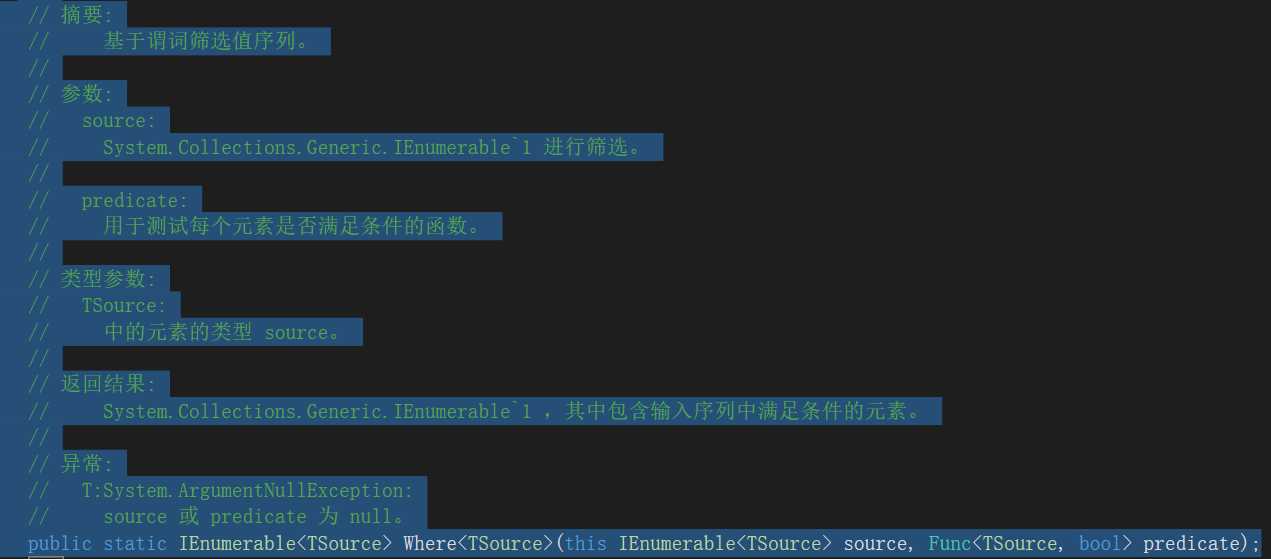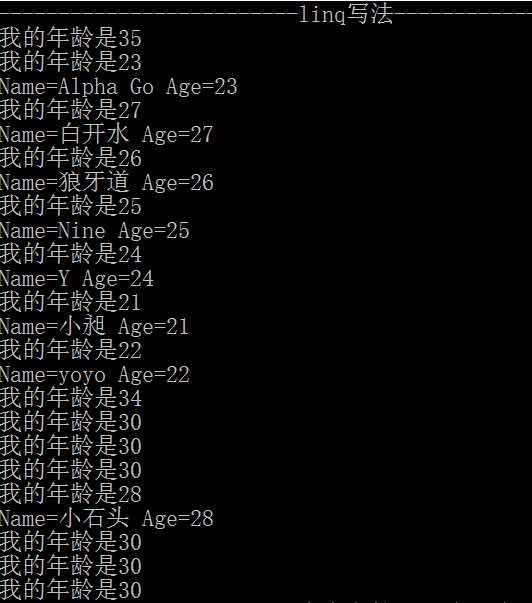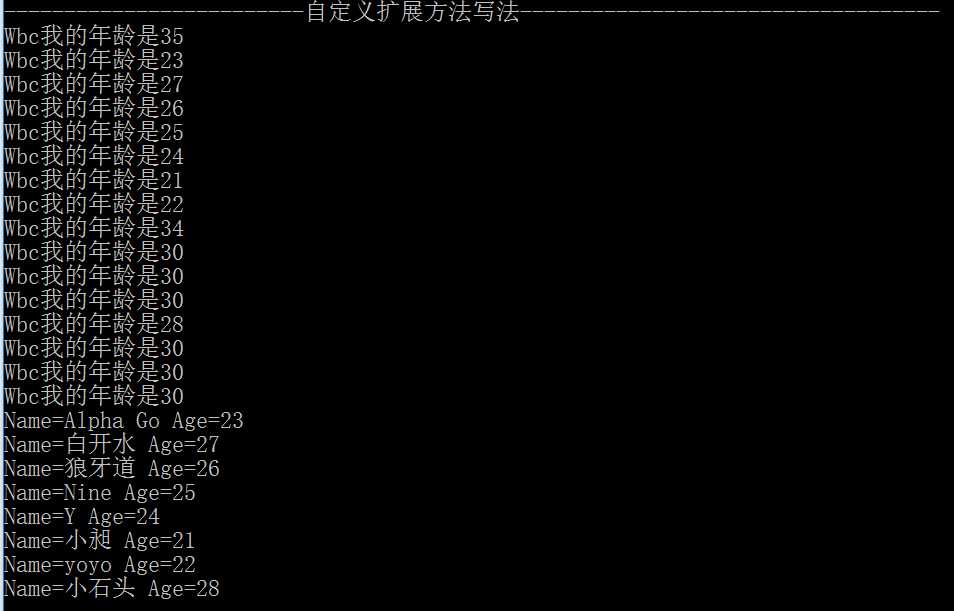要想学好linq to object 我们必须要先学习lambda 表达式,学习lambda 表达式呢我们必须了解匿名函数和匿名类,学习匿名函数,我们必须学会委托,这是本文的宗旨。下面开始第一步。在第一步开始之前,我们做点准备工作,建立一个学生类和一个班级类,类结构如下
public class Student { public int Id { get; set; } public int ClassId { get; set; } public string Name { get; set; } public int Age { get; set; } public void Study() { Console.WriteLine("{0} {1}跟着Eleven老师学习.net高级开发", this.Id, this.Name); } } public class Class { public int Id { get; set; } public string ClassName { get; set; } }
在准备一个基础数据类
public class LinqShow { /// <summary> /// 准备数据 /// </summary> /// <returns></returns> public List<Student> GetStudentList() { #region 初始化数据 List<Student> studentList = new List<Student>() { new Student() { Id=1, Name="打兔子的猎人", ClassId=2, Age=35 }, new Student() { Id=1, Name="Alpha Go", ClassId=2, Age=23 }, new Student() { Id=1, Name="白开水", ClassId=2, Age=27 }, new Student() { Id=1, Name="狼牙道", ClassId=2, Age=26 }, new Student() { Id=1, Name="Nine", ClassId=2, Age=25 }, new Student() { Id=1, Name="Y", ClassId=2, Age=24 }, new Student() { Id=1, Name="小昶", ClassId=2, Age=21 }, new Student() { Id=1, Name="yoyo", ClassId=2, Age=22 }, new Student() { Id=1, Name="冰亮", ClassId=2, Age=34 }, new Student() { Id=1, Name="瀚", ClassId=2, Age=30 }, new Student() { Id=1, Name="毕帆", ClassId=2, Age=30 }, new Student() { Id=1, Name="一点半", ClassId=2, Age=30 }, new Student() { Id=1, Name="小石头", ClassId=2, Age=28 }, new Student() { Id=1, Name="大海", ClassId=2, Age=30 }, new Student() { Id=3, Name="yoyo", ClassId=3, Age=30 }, new Student() { Id=4, Name="unknown", ClassId=4, Age=30 } }; #endregion return studentList; } }
简单了解委托
1. 委托是什么?
其实,我一直思考如何讲解委托,才能把委托说得更透彻。说实话,每个人都委托都有不同的见解,因为看问题的角度不同。个人认为,可以从以下2点来理解:
(1) 从数据结构来讲,委托是和类一样是一种用户自定义类型。
(2) 从设计模式来讲,委托(类)提供了方法(对象)的抽象。
既然委托是一种类型,那么它存储的是什么数据?
我们知道,委托是方法的抽象,它存储的就是一系列具有相同签名和返回回类型的方法的地址。调用委托的时候,委托包含的所有方法将被执行。
2. 委托类型的定义
委托是类型,就好像类是类型一样。与类一样,委托类型必须在被用来创建变量以及类型对象之前声明。
delegate void MyDel(int x);
委托类型声明:
(1) 以deleagate关键字开头。
(2)返回类型+委托类型名+参数列表。
3. 声明委托变量
MyDel del1,del2;
4. 初始化委托变量
(1) 使用new运算符
new运算符的操作数的组成如下:
- 委托类型名
- 一组圆括号,其中包含作为调用列表中的第一个成员的方法的名字。方法可以是实例方法或静态方法。
del1 = new MyDel( 实例方法名 ); del2 = new MyDel( 静态方法名 );
(2)使用快捷语法
快键语法,它仅由方法说明符构成。之所以能这样,是因为在方法名称和其相应的委托类型之间有隐式转换。
del1 = 实例方法名; del2 = 静态方法名;
5. 赋值委托
由于委托是引用类型,我们可以通过给它赋值来改变包含在委托变量中的方法地址引用。旧的引用会被垃圾回收器回收。
MyDel del; del = 实例方法名; //委托初始化 del = 静态方法名;//委托重新赋值,旧的引用将被回收
6. 委托调用
委托调用跟方法调用类似。委托调用后,调用列表的每个方法将会被执行。
在调用委托前,应判断委托是否为空。调用空委托会抛出异常,这是正常标准调用
if(null != del) { del.Invoke();//委托调用 }
在net 1.1的时代,我们是使用Invoke()方法类调用委托的。但是微软在net 2.0 的时候,我们可以这么去调用委托 直接 del();
if(null != del) { del();//委托调用 }
7. 综合练习
using System; using System.Collections.Generic; using System.Linq; using System.Text; using System.Threading.Tasks; namespace Test { class Program { public delegate void meathed1();//1 委托的声明 委托是一种类型 public delegate int meathed2();//2 可以声明在类的内部,也可以声明在类的外部 public delegate void meathed3(int id, string name); public delegate string meathed4(string msg); static void Main(string[] args) { meathed1 me1 = new meathed1(m1); meathed2 me2 = new meathed2(m2); meathed3 me3 = new meathed3(m3); meathed4 me4 = new meathed4(m4); me1.Invoke(); int result= me2.Invoke(); Console.WriteLine(result); me3(1, "wbc"); Console.WriteLine(me4("您吃了吗")); Console.Read(); } public static void m1() { Console.WriteLine("我是无参数无返回值的方法"); } public static int m2() { Console.WriteLine("我是无参数有返回值的方法~~~~~~~~~"); return 123; } public static void m3(int id, string name) { Console.WriteLine($"我是有参数无返回值的方法,id={id},name={name}"); } public static string m4(string sparams) { Console.WriteLine($"我是无参数无返回值的方法 ,参数{sparams}"); return "参数返回了"; } } }
8. net 框架提供的自带委托
8.1.Func委托类型
Func是有返回值的泛型委托,可以没有参数,但最多只有16个参数,并且必须要有返回值。
Func<string, int> funcDelegate = new Func<string, int>();
2.Action委托类型
Action是没有返回值的泛型委托,可以没有参数,但最多只有16个参数。
Action<string, string> method = new Action<string, string>();
关于泛型这里就不过多介绍了,本人前边写了一篇比较详细。建议大家以后使用委托的时候,尽量使用net 类库自带的委托。
匿名方法&lambda表达式
我们看了上面的委托,发现写起来好麻烦,并且用起来特别的不方便,有没有更简便的方法呢?可不可以把我们的方法写到委托里面呢?答案是肯定的;这种写法我们称为匿名方法。写法如下:
Action<string> method = new Action<string>(delegate(string name){ Console.WriteLine(name); }); method.Invoke("wbc"); Console.Read();
但是这种写法还不够简便,在.net 2.0的时候,我们发现1.1的时候在频繁的使用委托,微软做了很大的改进和更新,新的写法如下
Action<string> method = new Action<string>(name => Console.WriteLine(name) ); method.Invoke("wbc"); Console.Read();
在2.0里面,我们去掉了delegate关键字,如果子有一个参数的时候,连括号也省略了,用"=>"指向方法体,这个尖叫号等号我们读做“goes to”,如果方法只有一句话,连花括号也省略了。参数类型直接就可以推算出来。看一个复杂的案列
Func<string,int,string> method = new Func<string, int, string>((name,age) => { return $"{name}今年{age}岁了"; } ); string result= method.Invoke("wbc",0); Console.WriteLine(result); Console.Read();
其实我们的匿名方法就是lambda 表达式。
匿名类
有了匿名方法一定会有匿名类,在net 3.0的时候才有的匿名类,我们看下在没有匿名类的时候,我们是如何去写的。
object student = new { id=123, name="1234" }; Console.WriteLine(student); Console.Read();
这种写法只能输出 “{ id = 123, name = 1234 }”这种结果的Json 数据,并且我们在程序中不能使用student.id,会报错。看下匿名写法
var model = new { Id = 1, Name = "Alpha Go", Age = 21, ClassId = 2 }; Console.WriteLine(model.Age); Console.Read();
我们来看下var 关键字,其实var 关键字就是一个语法糖,我们不必过于在意,这里就不过多的演示了,我们的根本目的是linq to object
1. 必须在定义时初始化。也就是必须是var s = “abcd”形式,而不能是如下形式:
var s;
s = “abcd”;//这种写法是不允许的
2. 一但初始化完成,就不能再给变量赋与初始化值类型不同的值了。
3. var要求是局部变量。
4. 使用var定义变量和object不同,它在效率上和使用强类型方式定义变量完全一样。
这里在简要扩展点技术点“dynamic”,dynamic的用法和object差不多,区别是dynamic在编译的时候才声明的一个类型,但是本人建议在程序开发中尽量避开这个关键字,后续MVC 中在详细介绍,dynamic是net 40里面的关键字。
扩展方法
扩展方法必须建立在静态类中的静态方法,且第一个参数前边要加上this 关键字,使用扩展方法必须引用扩展方法所在的类的命名空间,如果想要全局使用,可以不带命名空间。个人建议程序中的扩展方法尽量要带上命名空间。我们来看下扩展方法的使用
using System; using System.Collections.Generic; using System.Linq; using System.Text; using System.Threading.Tasks; namespace Test { class Program { static void Main(string[] args) { int? a = null; Console.WriteLine(Helper.ToInt(a));//常规写法输出 Console.WriteLine(a.ToInt());//扩展方法输出 if ("1qazwsx1qazwsx1qazwsx1qazwsx".ToLengthInCount(16)) { Console.WriteLine("密码长度应当小于16个字符"); } Console.Read(); } } public static class Helper { /// <summary> /// 验证一个数字是否为空,为空返回-1 /// 扩展方法:静态类里的静态方法,第一个参数类型前面加上this /// </summary> /// <param name="iParameter"></param> /// <returns></returns> public static int ToInt(this int? iParameter) { return iParameter ?? -1; } /// <summary> /// 验证一个字符串长度是否大指定长度 /// /// </summary> /// <param name="sParameter"></param> /// <returns></returns> public static bool ToLengthInCount(this string sParameter, int iCount) { return sParameter.Length >= iCount ? true : false; } } }
这里简要说明下,扩展方法的方法名和类内不得方法名相同,会优先选择类内部的方法,这是以就近原则,去执行的,关于就近原则,请看本人java 相关博客,有介绍
linq to object
1. 什么是linq to object ?
LINQ即Language Integrated Query(语言集成查询),LINQ是集成到C#和Visual Basic.NET这些语言中用于提供查询数据能力的一个新特性。linq to object 就是对象查询体系。
注:LINQ(发音为Link)
我们来看一个简单的列子,用到了我们前边准备的两个类。我们要取出学生年龄小于30岁的,我们如果不会linq to object 的写法如下
LinqShow linq = new LinqShow(); List<Student> studentList = linq.GetStudentList();//获取基础数据 List<Student> studentListLessThan30 = new List<Student>(); foreach (var item in studentList) { if (item.Age < 30) { Console.WriteLine($"name={item.Name},age={item.Age}"); studentListLessThan30.Add(item); } } Console.Read();
我们可不可以使用委托去计算呢??
LinqShow linq = new LinqShow(); List<Student> studentList = linq.GetStudentList();//获取基础数据 List<Student> studentListLessThan30 = new List<Student>(); //Func<Student, bool> predicate = s => s.Age < 30;//写法一, //var list = studentList.Where<Student>(predicate);//linq var list = Enumerable.Where(studentList, s => s.Age < 30);//使用lambda 表达式写法 foreach (var item in list) { Console.WriteLine($"Name={item.Name} Age={item.Age}"); } Console.Read();
两段代码我就不比较了,这里我们只来剖析下 studentList 的Where方法,我们可以转移到定义看下,其实where 里面的参数,如下图

我们会发现,这不List<T>自带的一个方法,而是一个扩展方法,这个扩展方法在”System.Linq“命名空间的“public static class Enumerable”类下,也就是说根据扩展方法的特点,我们只要引用了“System.Linq”命名空间,就能使用这个扩展方法,这个扩展方法真的第二个参数是一个Func<TSource, bool> 委托,这个委托有一个TSource泛型参数,一个bool返回值。这就说明了我们上面的lambda 表达式是成立的。
继续剖析,我们接受的时候,没有使用List<Student>接收返回的集合,这是因为我们的linq 只有遇到循环的时候或遇到ToList<T>()的时候才会去迭代,这里涉及到迭代器的问题,后续我们会详细讲解迭代器的使用,或者大家去网上查询下设计模式迭代器。这么说,我们很难理解。我们通过一个案列来分析,自己写一个for 循环的扩展方法,对比下
using System; using System.Collections.Generic; using System.Linq; using System.Text; using System.Threading.Tasks; namespace Test { class Program { static void Main(string[] args) { LinqShow linq = new LinqShow(); List<Student> studentList = linq.GetStudentList();//获取基础数据 //var list = Enumerable.Where(studentList, s => s.Age < 30);//使用lambda 表达式写法, Console.WriteLine($"-------------------------linq写法-----------------------------------"); var list = studentList.Where( s => { Console.WriteLine($"我的年龄是{s.Age}"); return s.Age < 30; });//使用lambda 表达式写法,这里在每一次计算,我们都输出一个我的年龄是,这里不再使用 Enumerable 去调用where ,反正是扩展方法,用法是一样的 foreach (var item in list) { Console.WriteLine($"Name={item.Name} Age={item.Age}"); } Console.WriteLine($"-------------------------自定义扩展方法写法-----------------------------------"); var Wbclist = studentList.WbcWhere(s => { Console.WriteLine($"Wbc我的年龄是{s.Age}"); return s.Age < 30; });// 自定义扩展方法写法 这里不再使用 Enumerable 去调用where foreach (var item in Wbclist) { Console.WriteLine($"Name={item.Name} Age={item.Age}"); } Console.Read(); } } public static class Helper { /// <summary> /// 自定义扩展方法计算集合 /// </summary> /// <typeparam name="TSource"></typeparam> /// <param name="source"></param> /// <param name="predicate"></param> /// <returns></returns> public static IEnumerable<TSource> WbcWhere<TSource>(this IEnumerable<TSource> source, Func<TSource, bool> predicate) { //常规情况下数据过滤 List<TSource> studentListLessThan30 = new List<TSource>(); foreach (var student in source) { //if (item.Age < 30) if (predicate(student)) { studentListLessThan30.Add(student); } } return studentListLessThan30; } /// <summary> /// 验证一个数字是否为空,为空返回-1 /// 扩展方法:静态类里的静态方法,第一个参数类型前面加上this /// </summary> /// <param name="iParameter"></param> /// <returns></returns> public static int ToInt(this int? iParameter) { return iParameter ?? -1; } /// <summary> /// 验证一个字符串长度是否大指定长度 /// /// </summary> /// <param name="sParameter"></param> /// <returns></returns> public static bool ToLengthInCount(this string sParameter, int iCount) { return sParameter.Length >= iCount ? true : false; } } }
我们来看下输入结果


通过执行结果,我们会发现,自定义的扩展方法是循环一遍,统一输出的,没有延迟,而linq 的写法有延迟。这也就是我们linq 核心之一 “linq 是有延迟的”。这里特别说明,linq 的延迟加载和EF ,ORM 的延迟加载,不是一会事,这里说的延迟,指的是当用到某条数据的时候,才会去查询。
2. 高逼格装X时刻
我们以llambda表达式去写linq 称为 查询运算符写法,下边我们 使用 查询表达式去写,注意区分什么是查询表达式,什么是查询运算符写法,我面试的很多人都说反了。
案列一 多条件过滤筛选数据
LinqShow linq = new LinqShow(); List<Student> studentList = linq.GetStudentList();//获取基础数据 //查询运算符 var list1 = studentList.Where<Student>(s => s.Age < 30 && s.Name.Length > 3);//陈述句 foreach (var item in list1) { Console.WriteLine("Name={0} Age={1}", item.Name, item.Age); } //查询表达式 Console.WriteLine("********************"); var list2 = from s in studentList where s.Age < 30 && s.Name.Length > 3 select s; foreach (var item in list2) { Console.WriteLine("Name={0} Age={1}", item.Name, item.Age); } Console.Read();
我们会发现,表达式的写法是不是很像sql ,语法以from 对象 ... in .. where select 对象 ,是不是很高大上,够逼咯吧!!!!!!,下边在简单介绍几个案列
案列二将筛选数据付给匿名类或者实体类
{ Console.WriteLine("********************"); var list = studentList.Where<Student>(s => s.Age < 30) .Select(s => new { IdName = s.Id + s.Name, ClassName = s.ClassId == 2 ? "高级班" : "其他班" }); foreach (var item in list) { Console.WriteLine("Name={0} Age={1}", item.ClassName, item.IdName); } } { Console.WriteLine("********************"); var list = from s in studentList where s.Age < 30 select new { IdName = s.Id + s.Name, ClassName = s.ClassId == 2 ? "高级班" : "其他班" }; foreach (var item in list) { Console.WriteLine("Name={0} Age={1}", item.ClassName, item.IdName); } }
案列三 排序分页
var list = studentList.Where<Student>(s => s.Age < 30) .Select(s => new { Id = s.Id, ClassId = s.ClassId, IdName = s.Id + s.Name, ClassName = s.ClassId == 2 ? "高级班" : "其他班" }) .OrderBy(s => s.Id)//首先升序排序 .OrderByDescending(s => s.ClassId)//首先降序排序 .ThenBy(s => s.ClassId)//升序降序排序以后再排序 .Skip(2)//跳过 分页 .Take(3)//获取数据 ; foreach (var item in list) { Console.WriteLine($"Name={item.ClassName} Age={item.IdName}"); }
案列四 关联查询
首先添加班级数据

List<Class> classList = new List<Class>() { new Class() { Id=1, ClassName="初级班" }, new Class() { Id=2, ClassName="高级班" }, new Class() { Id=3, ClassName="微信小程序" }, };
表达式写法
var list = from s in studentList join c in classList on s.ClassId equals c.Id select new { Name = s.Name, CalssName = c.ClassName }; foreach (var item in list) { Console.WriteLine($"Name={item.Name},CalssName={item.CalssName}"); }
算数运输符写法
var list = studentList.Join(classList, s => s.ClassId, c => c.Id, (s, c) => new { Name = s.Name, CalssName = c.ClassName }); foreach (var item in list) { Console.WriteLine($"Name={item.Name},CalssName={item.CalssName}"); }
在linq 中没有右链接,如果要写右链接,只能反过来写,这里不过多去写案列了,这种案列网上很多,一会总结过后,分享几篇
总结及推荐
1.匿名函数只能使用在委托中
2.var 关键字的特点,如何使用var 实现匿名类。
3. lambda 表达式
4.扩展方法
5.运算符linq 写法
6.表达式linq 写法
7 linq 的延迟加载原理
分享 1 linq 案列 ,很全面的
分享2 linq 标准查询操作符 很全面的 共五篇

